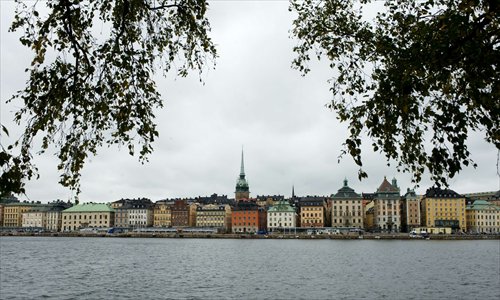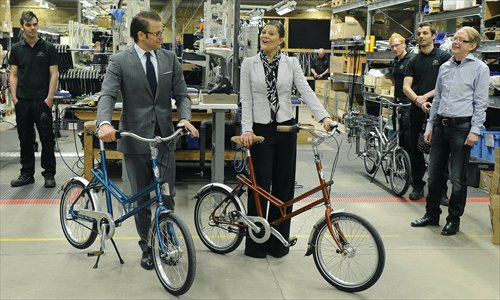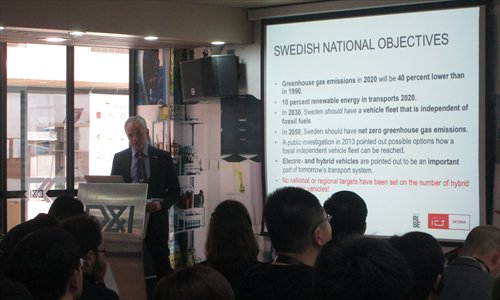Towards a better city

A view of Stockholm Photos: CFP
About half the world's population now lives in cities, and it's estimated that by the middle of this century, 70 percent of the world will be urbanized. According to a recently released report, the National New Urbanization Plan in China (2014-2020), 60 percent of China's population will live in cities within six years, that is about a 6 percent increase on the present numbers.
The city of Shanghai is home to 24 million people spread over its 6,340 square kilometers and has achieved great things in economics, finance, culture, transportation and public services in its recent rapid urbanization. But like other large cities in the world it also faces serious challenges as its population increases and the dearth of land and energy become evident.
How can the city develop in a sustainable way and how will city residents be able to develop their lives and lifestyles in new smart ways? In March experts from China and Sweden got together in Shanghai to discuss the future and some feasible solutions to the challenges.
From March 20 to 27, the Consulate General of Sweden in Shanghai, the Färgfabriken (Foundation of Art, Architecture and Urbanism) from Stockholm and the College of Design and Innovation in Tongji University worked together to present an exhibition, three seminars and three workshops all with the "Smart Urban Living" theme.

Sweden's Crown Princess Victoria and Prince Daniel visit a bike factory. Photo: CFP
Swedish experiences
Viktoria Li, the consul general of Sweden in Shanghai, noted at the opening ceremony of the exhibition, Stockholm on the Move, "Some of our Swedish cities today are the world's cleanest, most innovative, and most livable cities. We're very happy about that and we're also very happy to share our experiences and to see what experiences can be used by others."
The exhibition, which runs at the Tongji University College of Design and Innovation until April 20, looks at the past, present and future of the fastest-growing capital in Northern Europe, showcasing the development of its infrastructure and innovative city-planning strategies.
The seminars discussed solutions to air pollution, inefficient traffic systems and unsustainable lifestyles, from the perspective of business, government and academics while the workshops encouraged younger thinkers, especially students living in Shanghai, to contribute their ideas on intelligent urban eating, travelling and living.
Lu Ximing, the vice director of the Urban Traffic Planning Committee of China, told the traffic seminar on Thursday that Shanghai and Stockholm had begun working together to develop efficient traffic systems three decades ago.
"At that time, the population of Shanghai was under 10 million, but every day, with a fleet of 5,000 buses, the city saw commuters taking 15 million rides on public transport," Lu recalled. "Over the past 30 years, Shanghai's transport system has developed much more than the other large cities in China and both its curbs on private cars and the expansion of public transport have proved to be very effective."
But continuing to improve transport efficiency and controlling carbon emissions leaves the city with a lot of new challenges.
Taking part in the seminar were officials from the transport department of the Pudong New Area, program directors from the Swedish auto manufacturer Volvo, as well as experts from the Viktoria Swedish ICT, a nonprofit research institute dedicated to promoting sustainable mobility by using information and communication technology.
Swedish and Chinese experts have been working together on various sustainable transport methods from introducing environmentally-friendly vehicles (including hybrid and plug-in electric buses and cars), promoting shared transport such as car pooling and public bike systems and exchanging information on transport innovations.

New energy vehicles help improve transport efficiency and control carbon emissions. Photo: CFP
Creative renovation
In the meantime, it has become more acceptable for city planners seeking to create sustainable new environments not to destroy old buildings and infrastructure with new construction.
Many architects and designers now prefer to create something energy-efficient and environmentally-friendly using existing architecture and infrastructure.
Anna Hessie is a senior architect and manager of overseas operations at Sweco, the leading Swedish company that designed Luodian New Town in Baoshan district as well as the Swedish and Norwegian pavilions for the World Expo 2010 in Shanghai.
At a seminar on Tuesday she outlined her experiences when she designed the renovation of a 1960s Stockholm building, turning it into a modern and efficient headquarters for Sweco. The new design saw the building's energy consumption reduced by 65 percent. Office workers are encouraged to use bikes and environmentally-friendly cars can park there for free.
Shanghai also has some examples of turning the old into environmentally-friendly new structures: a former slaughterhouse has been turned into the popular cultural and creative hub 1933 Shanghai; a former airport in Xuhui district has been renovated into the Yuz Museum, an art gallery; and one of the most anticipated projects will be the DreamCenter, which will see more than a dozen old factories and shipyards turned into a vast state-of-the-art theater, cinema, entertainment and shopping complex on the west bank of the Huangpu River.

Researcher Johan Wedlin speaks at a seminar. Photo: Sun Shuangjie/GT
Inspiration in China
The information flow between Sweden and China is a two-way process of communication and inspiration and not merely the export of Swedish ideas.
Hessie told the seminar that, during her stay in China, she and her colleagues had learned a lot, and Sweco designs have become more comprehensive including ideas from Shanghai people rather than being purely Scandinavian.
Like Sweco, other Swedish companies are heading to China, mostly to Shanghai, to interact with local needs and local talent to promote sustainable living.
Kaj Töröks, a communications strategist and a co-founder of Futerra Sustainability Communications in Stockholm, brought the Smart Living Challenge contest workshops from Stockholm to Shanghai last week.
Smart Living Challenge is an international competition designed to generate ideas and business opportunities that promote a sustainable urban lifestyle, and is divided into three categories - Eat, Live and Move.
Participants are asked to hand in their proposals (a new product, service or solution) to a jury which selects 15 winners and helps them develop and realize their projects.
About 80 people participated in the workshops at Tongji University, Shanghai Jiao Tong University and Shanghai design firm China Bridge and submitted projects in groups. The Shanghai workshops were the second stop, after Belgrade, in a tour of 10 foreign countries.
"We believe that in these young people there is great potential and possibilities that may surprise the industry," said Töröks, noting big Swedish companies like ABB are among the clients developing the winning projects.
It is never going to be easy or quick achieving sustainable development. The concept of sustainable development began to take shape in the 1980s, almost 200 years after the first industrial revolution. Over the past few years although many people from different countries have been working to solve environmental problems, the resources and energy supplies of the planet are being used up and species are also vanishing at an astounding speed.
Pius Leuba dit Galland, a Swiss architect and an associate professor at Tongji University, told the Global Times: "I think the first generation pushes the notion of sustainability into people's minds, the second generation begins to think how to start implementing it, and the third generation can go beyond just fixing problems and begin to do something that will benefit the planet.
"But it's interesting in China - the country's development is so fast that all three generations are now here together," said Galland, who has been in Shanghai for 10 years.
"So the movement will be much faster than we see it in the West, because the first generation of people here can know people who are thinking as the third generation," Galland said. He believes that many foreign companies and designers can learn about sustainability faster in China.